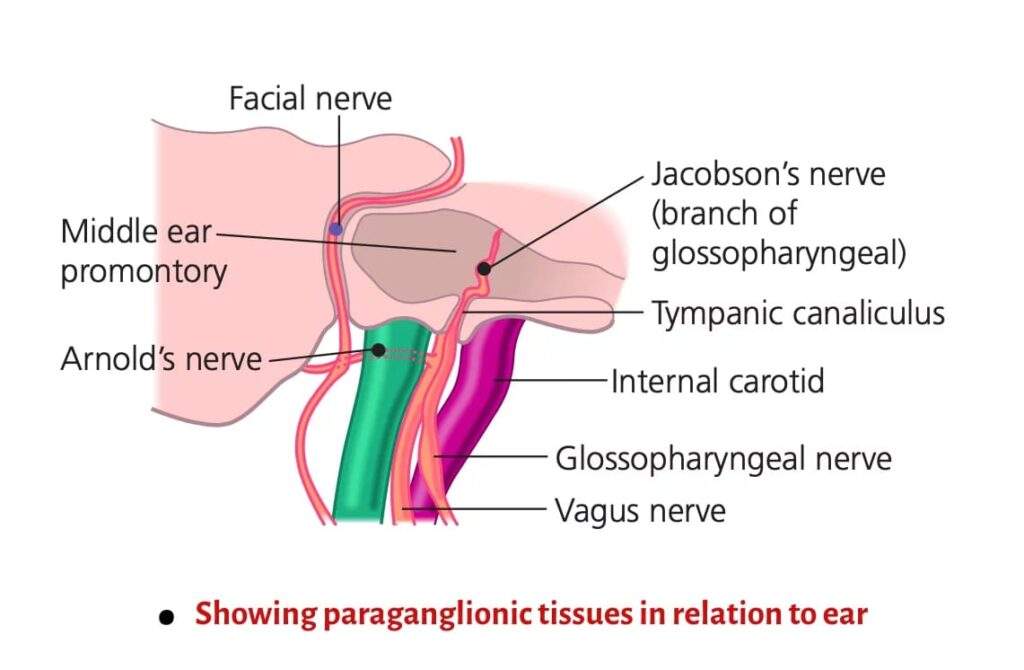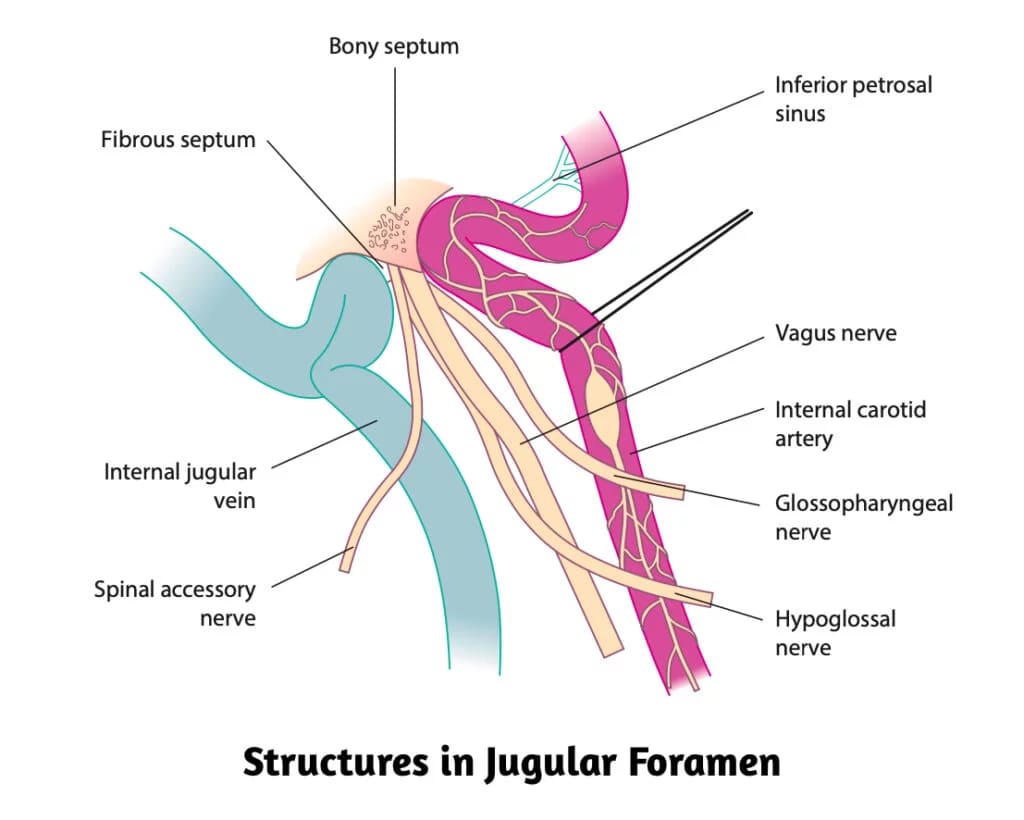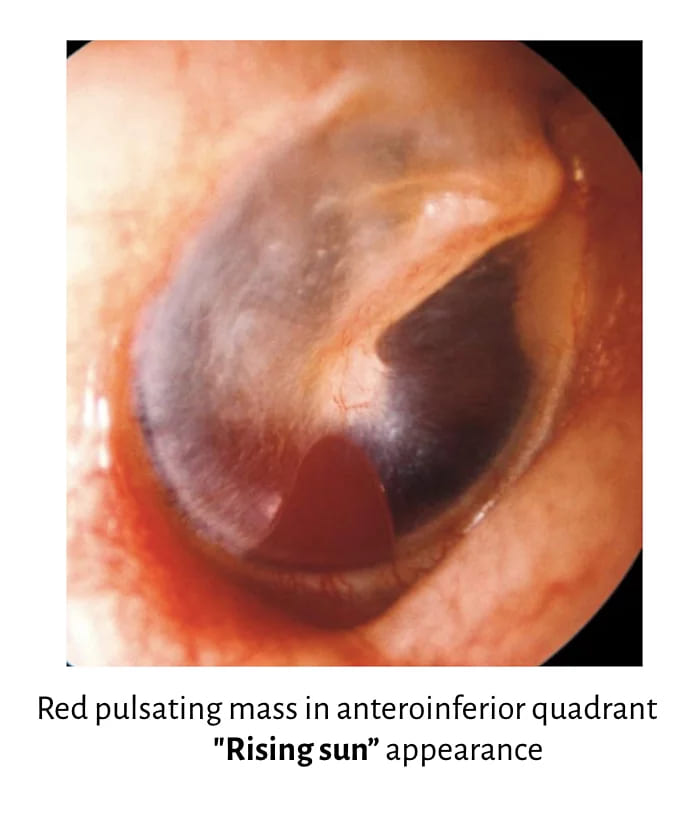Glomus Tumour (Paraganglioma of Temporal Bone)
Introduction & Clinical Importance
Glomus tumours, also known as paragangliomas or chemodectomas, are the most common benign neoplasms of the middle ear and the second most common tumours of the temporal bone. It was first described by Guild (Glasscock, 1982).
Although histologically benign, these highly vascular tumours can be locally aggressive, causing multiple cranial nerve abnormalities and morbidity if not promptly diagnosed and treated. They are crucial to recognise due to their clinical mimicry of chronic ear diseases and their surgical complexity.
Aetiology & Pathophysiology
- Origin: Arise from neural crest-derived paraganglionic cells (glomus bodies).
- Common locations of glomus bodies: Dome of the jugular bulb and promontory along the tympanic branch of the glossopharyngeal nerve (Jacobson’s nerve).
- Nature: Slow-growing, nonencapsulated, but extremely vascular, and it rarely metastasises.
- Age: Often seen in the 5th and 6th decades of life.
- Gender: Female predominance (5:1).
- Familial occurrence: 10% familial, 10% multicentric (occurring in more than one site), and 10% functional (secreting catecholamines).
- Feeding vessel: Ascending pharyngeal artery (branch of external carotid artery).
- Pathology: Macroscopically, all paragangliomas are firm, well-circumscribed lesions that are yellow, tan, brown or reddish in colour. They can have a thin, but focally thickened, fibrous capsule. Microscopically, it reveals masses or sheets of epithelial cells characterised by large nuclei and granular cytoplasm. There is an abundance of thin-walled blood sinusoids with no contractile muscle coat, accounting for profuse bleeding from the tumours.

Common Sites of Paragangliomas
| Site | Type |
|---|---|
| Middle ear | Glomus tympanicum |
| Jugular fossa | Glomus jugulare |
| Carotid bifurcation | Glomus caroticum |
| Vagus nerve ganglion | Glomus vagale |
1. Glomus Tympanicum. It is the most common middle ear tumour. It arises from the paraganglion located in the promontory. They are located along the tympanic branch (Jacobson’s nerve) of the glossopharyngeal nerve and the auricular branch (Arnold’s nerve) of the vagus nerve. In contrast to glomus jugulare, bone erosion is rare in glomus tympanicum (the hypotympanic floor, jugular fossa and ossicles are usually intact). A large tumour may cause a bulge of the tympanic membrane and a smooth indentation of the promontory, causing aural symptoms. Posteriorly, it may extend into the mastoid and inferiorly into the hypotympanic air cells and jugular fossa.
CT is the investigation of choice for diagnosis. Axial and coronal sections show a well-defined nodular area of soft tissue on the cochlear promontory. MRI is only indicated for larger lesions extending outside the middle ear cavity. It seldom requires preoperative embolisation and can be resected with conventional tympanoplasty techniques.
2. Glomus Jugulare. It arises from the paraganglion located in the jugular bulb, the Xth nerve ganglion, and/ or from the Arnold or Jacobson nerves.
Glomus jugulare tumours erode the jugular fossa and break through the bony roof of the jugular fossa, causing neurological signs of IXth to XIIth cranial nerve involvement. Destruction of bone around the caroticojugular spine, jugular tubercle, and hypoglossal canal may also be seen. As the tumour increases in size, it causes erosion of the floor of the hypotympanum and may fill the entire middle ear cavity and from there into the external auditory canal.
Lateral extension of the lesion into the mastoid often leads to erosion of the facial canal and involvement of the facial nerve. Medially, it invades the petrous pyramid and destruction of perilabyrinthine bone and the petrous apex. Extracranially, it may compress the jugular vein or invade its lumen. Intracranial involvement is often observed in large tumours, although the lesion usually remains extradural.
Spread of Glomus Jugulare Tumour
- As the floor of the hypotympanum is eroded, the tumour extends superiorly into the middle ear cavity and later perforates through the tympanic membrane to present into the external auditory canal as a vascular polyp.
- It may invade the labyrinth, the petrous pyramid and the mastoid.
- It may invade the jugular foramen and the base of skull, causing IXth to XIIth cranial nerve palsies.
- By spreading through the eustachian tube, it may present in the nasopharynx.
- Intracranially, it may spread to the posterior and middle cranial fossae. Intracranial involvement is often observed in large tumours, although the lesion usually remains extradural.
- Metastatic spread to lungs and bones is rare, but is seen in 4% of cases. Metastatic lymph node enlargement can also occur.
MRI is the study of choice and shows a characteristic ‘salt and pepper’ appearance on T1 images, which is a combination of flow voids from intratumoural vessels and areas of micro-haemorrhage.
CT of glomus jugulare helps in the detection of the bony changes. CT of glomus jugulare shows a typical pattern of permeative bone destruction that involves the carotico-jugular spine early in the disease process.

Fisch classification for glomus tumours. It helps in surgical planning and provides standards for reporting surgical results.
- Type A tumour: Limited to the middle ear cleft (glomus tympanicum)
- Type B tumour: Limited to the tympanomastoid area with no infra-labyrinthine compartment involvement
- Type C tumour: Involving the infra labyrinthine compartment of the temporal bone and extending into the petrous apex
- Type C1 tumour: With limited involvement of the vertical portion of the carotid canal
- Type C2 tumour: Invading the vertical portion of the carotid canal
- Type C3 tumour: Invasion of the horizontal portion of the carotid canal
- Type D1 tumour: With an intracranial extension <2 cm in diameter
- Type D2 tumour: With an intracranial extension >2 cm in diameter
Clinical features:
Almost 90% of skull base paragangliomas have conductive hearing loss and symptoms pertain to the ear.
- Pulsatile tinnitus and/ or hearing loss. The earliest symptoms are pulsatile tinnitus and/ or hearing loss. Tinnitus is swishing in character, synchronous with pulse and can be temporarily stopped by carotid pressure. A glomus tympanicum may present early with conductive hearing loss, which is slowly progressive in nature; whereas glomus jugulare may present with a mixed deafness when the middle and inner ears are both involved. There may be otalgia, ear fullness, otorrhea and aural bleeding.
- Polypoidal mass. On examination red, vascular polyp in the ear canal may be present in advanced disease. It bleeds readily and profusely, either spontaneously or on attempts to clean it or at biopsy.
- Dizziness or vertigo.
- Earache is generally not present. Absence of earache differentiates it from carcinoma of the external and middle ear.
- Ear discharge may be seen due to secondary infection, and the condition may simulate chronic suppurative otitis media with polyp.
- Tumour mass. Tumour may present as a mass over the mastoid or in the nasopharynx.
- Cranial Nerve Palsies. This is a late feature appearing several years after aural symptoms. CN VII and VIII become involved in the internal auditory canal. IXth to XIIth cranial nerves become involved in the jugular foramen. Order of frequency of involvement (VII > X > XII > IX > XI). There is dysphagia and hoarseness with asymmetric palatal elevation or an abnormal gag reflex (IX, X) and dysarthria and hoarseness of voice due to unilateral paralysis of vocal cords (X) with weakness of the trapezius and sternomastoid muscles (XI) and deviation on protrusion, wasting and atrophy of tongue (XII) nerves. Horner’s syndrome (ptosis, meiosis, anhydrosis and enopthalmus) can be observed.
- Audible Bruit. Auscultation with a stethoscope should be done over the upper neck and mastoid, which may reveal “systolic bruit”, which is indicative of underlying pathology.
- Catecholamine symptoms. Headache, sweating, palpitation, hypertension and anxiety.

Diagnosis:
- On otoscopic examination reddish-blue reflex may be seen through intact tympanic membrane. If tumour is arising from the promontory, red pulsatile mass may be seen behind the tympanic membrane, and glomus tympanicum tumour is the most likely diagnosis. If the tumour is arising from the floor of the middle ear, ‘Rising sun appearance’ is seen, and glomus jugulare tumour is the most likely diagnosis. Tympanic membrane also appears blue in cases of haemotympanum (temporal bone fracture), glue ear, glomus tumour and haemangioma of the middle ear.
- “Pulsation sign” (Brown’s sign) is positive, i.e. when ear canal pressure is raised with Siegel’s speculum, the tumour pulsates vigorously and then blanches; reverse happens with the release of pressure.
- Polypoidal mass. On examination red, vascular polyp in the ear canal may be present in advanced disease. It bleeds readily and profusely, either spontaneously or on attempts to clean it or at biopsy. Preoperative biopsy or myringotomy is contraindicated. Avoid injuring the high jugular bulb (which appears darker in colour) or the aberrant internal carotid artery (normally placed in the anterior mesotympanum).
- Inspection and palpation of the neck (cervical mass and trapezius weakness in extensive jugulotympanic glomus). Examination of the neck is also important in patients with glomus tumours to identify synchronous paragangliomas or detect direct extension of a large tumour into the neck (e.g. glomus jugulare or vagale).
- Inspection of the oral cavity and pharyngolarynx (tongue deviation, decreased gag reflex, vocal cord paresis in extensive jugulotympanic glomus).
Investigations:
A combination of CT, MRI and angiography is required for assessment of patients with glomus tumours.
- Computed Tomography (CT) Scan Head. Helps in differentiating glomus tympanicum from the glomus jugulare tumour by identification of caroticojugular spine, which is eroded in the latter. CT scan also helps to differentiate it from the aberrant carotid artery, high or dehiscent jugular bulb.
- MRI. It shows soft tissue extent of the tumour. Magnetic resonance angiography and venography further help to delineate invasion of the jugular bulb and vein or compression of the carotid artery.
- CT Head and MRI Combined. Together provide excellent preoperative guidance in the differential diagnosis of petrous apex lesions.
- Four-Vessel Angiography. It is necessary when CT head shows involvement of the jugular bulb, carotid artery or intradural extension. It also helps to delineate any other glomus tumour (as they may be multiple), find the feeding vessels or embolisation of the tumour if required.
- Brain Perfusion and Flow Studies. They are necessary when the tumour is pressing on the internal carotid artery. If the case needs surgery, brain perfusion and adequacy of the contralateral internal carotid artery and the circle of Willis can be assessed. If needed, xenon blood flow and isotope studies are done for precise blood flow, and the risk of stroke and need for surgical replacement of the internal carotid artery.
- Catecholamine secretion: Serum levels of catecholamines or their breakdown products in 24-h urine (metanephrine, vanillylmandelic acid).
- Pure tone and speech audiometry to assess the type and degree of hearing loss. Vestibular function tests for dizziness or vertigo.
TREATMENT:
- Surgical removal. Treatment of choice is complete surgical excision. The surgical approach depends on the limits of the tumour and its classification. Surgical approaches to glomus tumours:
- Transcanal Approach. Suited for limited glomus tympanicum tumour where the entire circumference of the tumour is visible, only tympanotomy will suffice to gain access to the tumour. Indicated in Fisch Type A tumour.
- Hypotympanic Approach. Suited for tumours limited to the promontory with extension to the hypotympanum but not into the mastoid. A superiorly based tympanomeatal flap is raised by the postauricular approach. Bony inferior tympanic ring is drilled away to see the lower limit of tumour.
- Extended Facial Recess Approach. Used for glomus tympanicum extending into mastoid but not into the jugular bulb. If extensive, modified radical operation is done.
- Mastoid-Neck Approach. Used for glomus jugulare tumours not extending to internal carotid artery, posterior cranial fossa or neck.
- Infratemporal Fossa Approach of Fisch. Used for large glomus jugulare tumours.
- Transcondylar Approach. Used for tumours extending towards foramen magnum. Usually they are recurrent glomus jugulare tumours. It gives approach to craniocervical junction with exposure of occipital condyle and jugular tubercle.
- Radiation. Irradiation may be appropriate for tumours impossible to remove surgically, having intracranial extension, residual tumours, or for old patients with limited life expectancy. The aim is to reduce its vascularity and bring about sclerosis and fibrosis, hence arrest its growth.
- Embolisation reduces the vascularity of the tumour. It is done before the surgery to reduce intra-operative bleeding and gives a comparatively clean operative field during surgery. Thereby, it reduces the chances of complications and intraoperative time. Embolisation of feeding vessels is done 1–2 days before the operation. Embolisation can also be done in inoperable patients who have received radiation. Gelfoam and coils can be used in feeding vessel occlusion proximal to the tumour. Gelfoam powder is derived from pork-skin gelatin.
- Combination of the above techniques.
———— End of the chapter ————
MCQs (NEET PG / INI-CET Standard)
1️ Most common tumour of middle ear:
- A) Cholesteatoma
- B) Glomus tympanicum ✅
- C) Otosclerosis
- D) Carcinoma
2️ Salt and pepper MRI appearance seen in:
- A) Cholesteatoma
- B) Acoustic neuroma
- C) Glomus tumour ✅
- D) Cholesterol granuloma
3️ Brown’s sign is:
- A) Bleeding on biopsy
- B) Mass blanches on pressure ✅
- C) Blue tympanic membrane
- D) Loss of gag reflex
4️ Earliest symptom of glomus tumour:
- A) Vertigo
- B) Otorrhea
- C) Hearing loss and tinnitus ✅
- D) Earache
5️ Major arterial supply to glomus tumour:
- A) Internal carotid artery
- B) Ascending pharyngeal artery ✅
- C) Facial artery
- D) Subclavian artery
6️ Positive Brown’s sign suggests:
- A) Perilymph fistula
- B) Paraganglioma ✅
- C) CSOM
- D) Otosclerosis
7️ Most common cranial nerve involved:
- A) IX
- B) VII ✅
- C) X
- D) XI
8️ Functioning glomus tumour secretes:
- A) Dopamine
- B) Catecholamines ✅
- C) Insulin
- D) Prolactin
9️ Site for glomus jugulare origin:
- A) Promontory
- B) Jugular bulb ✅
- C) Tympanic membrane
- D) Carotid canal
10Which investigation confirms vascular anatomy?
- A) CT
- B) Angiography ✅
- C) MRI
- D) Ultrasound
FAQs
- What is glomus tumour? Glomus tumour is a benign but highly vascular tumour arising from paraganglionic tissue in the temporal bone.
- What are common symptoms of glomus tumour? The earliest symptoms include pulsatile tinnitus and conductive hearing loss. Advanced cases show cranial nerve palsies.
- How is glomus tumour diagnosed? Diagnosis is based on clinical examination, CT, MRI (salt and pepper appearance), and angiography for vascular mapping.
- What is Brown’s sign? Brown’s sign is blanching of the vascular mass on pneumatic otoscopy, characteristic of glomus tumours.
- What is the treatment of glomus tumour? Surgical removal is the mainstay. Radiation and embolization may be used in select cases.
- What is the Fisch classification? It classifies glomus tumours based on size and spread, guiding surgical approach.
- Can glomus tumour secrete hormones? Yes, functional glomus tumours may secrete catecholamines causing hypertension, palpitations, and sweating.
———— End of the chapter ————
Download full PDF Link:
Glomus Tumour Best Lecture Notes Dr Rahul Bagla ENT Textbook
Reference Textbooks.
- Scott-Brown, Textbook of Otorhinolaryngology-Head and Neck Surgery.
- Glasscock-Shambaugh, Textbook of Surgery of the Ear.
- P L Dhingra, Textbook of Diseases of Ear, Nose and Throat.
- Hazarika P, Textbook of Ear Nose Throat And Head Neck Surgery Clinical Practical.
- Mohan Bansal, Textbook of Diseases of Ear, Nose and Throat Head and Neck Surgery
- Hans Behrbohm, Textbook of Ear, Nose, and Throat Diseases With Head and Neck Surgery.
- Salah Mansour, Middle Ear Diseases – Advances in Diagnosis and Management.
- Logan Turner, Textbook of Diseases of The Nose, Throat and Ear Head And Neck Surgery.
- Rob and smith, Textbook of Operative surgery.
- Anirban Biswas, Textbook of Clinical Audio-vestibulometry.
- Arnold, U. Ganzer, Textbook of Otorhinolaryngology, Head and Neck Surgery.
Author:

Dr. Rahul Bagla
MBBS (MAMC, Delhi) MS ENT (UCMS, Delhi)
Fellow Rhinoplasty & Facial Plastic Surgery.
Renowned Teaching Faculty
Mail: msrahulbagla@gmail.com
India
———– Follow us on social media ————
- Follow our Facebook page: https://www.facebook.com/Dr.Rahul.Bagla.UCMS
- Follow our Instagram page: https://www.instagram.com/dr.rahulbagla/
- Subscribe to our Youtube channel: https://www.youtube.com/@Drrahulbagla
- Please read. Anatomy of External Ear. https://www.entlecture.com/anatomy-of-ear/
- Please read. Anatomy of Temporal Bone. https://www.entlecture.com/anatomy-of-temporal-bone/
- Please read. Stenger’s, Chimani Moos, Teal test. https://www.entlecture.com/special-tuning-fork-tests/
Keywords: Glomus tumor ear, Glomus jugulare tumour, Symptoms of glomus tumor in ear, Glomus tympanicum tumor treatment, ENT diagnosis of glomus tumor, Pulsatile tinnitus glomus tumor, Surgery for glomus tumor in ear, Causes of glomus tumor, MRI features of glomus tumor, Glomus tumor case study ENT, Glomus tumor vs acoustic neuromaglomus jugulare complications, Vascular tumor middle ear, Paraganglioma ear tumor, Ear tumor ENT notes, Glomus tumor PDF notes, Glomus tumor NCERT, Glomus tumor larynx ENT, Red mass behind tympanic membrane, Pulsation sign, Rising sun appearance, Glomus tympanicum, Glomus jugulare, Glomus caroticum, Glomus vagale, Glomus tumour, Paraganglioma, Glomus tumour diagnosis, Symptoms of glomus tumor, Glomus jugulare treatment, Paraganglioma vs glomus tumour, Imaging for glomus tumors, Glomus tumour surgery outcomes, Causes of glomus tumor, Glomus tympanicum diagnosis, Rare vascular tumours ear, Glomus tumour hearing loss, Skull base paraganglioma, Glomus tumour ENT approach, Genetic link glomus tumor, Recurrence glomus tumours

Well, that’s good 👍